Eighteen Years of Kilonova Discoveries with Swift
Abstract
1. Introduction
2. Kilonovae Associated with Gravitational Wave Counterparts
3. Kilonovae Associated with Short GRBs
3.1. Kilonovae in the Nearby Universe
3.2. Kilonovae at Cosmological Distances
4. Kilonovae Associated with Hybrid Long GRBs
5. Conclusions
Funding
Data Availability Statement
Acknowledgments
Conflicts of Interest
References
- Li, L.X.; Paczyński, B. Transient Events from Neutron Star Mergers. Astrophys. J. Lett. 1998, 507, L59–L62. [Google Scholar] [CrossRef]
- Metzger, B.D. Kilonovae. Living Rev. Relativ. 2019, 23, 1. [Google Scholar] [CrossRef] [PubMed]
- Baiotti, L.; Rezzolla, L. Binary neutron star mergers: A review of Einstein’s richest laboratory. Rep. Prog. Phys. 2017, 80, 096901. [Google Scholar] [CrossRef] [PubMed]
- Bauswein, A.; Goriely, S.; Janka, H.T. Systematics of Dynamical Mass Ejection, Nucleosynthesis, and Radioactively Powered Electromagnetic Signals from Neutron-star Mergers. Astrophys. J. Lett. 2013, 773, 78. [Google Scholar] [CrossRef]
- Korobkin, O.; Rosswog, S.; Arcones, A.; Winteler, C. On the astrophysical robustness of the neutron star merger r-process. Mon. Not. R. Astron. Soc. 2012, 426, 1940–1949. [Google Scholar] [CrossRef]
- Rosswog, S.; Liebendörfer, M.; Thielemann, F.K.; Davies, M.B.; Benz, W.; Piran, T. Mass ejection in neutron star mergers. Astron. Astrophys. 1999, 341, 499–526. [Google Scholar] [CrossRef]
- Freiburghaus, C.; Rosswog, S.; Thielemann, F.K. R-Process in Neutron Star Mergers. Astrophys. J. Lett. 1999, 525, L121–L124. [Google Scholar] [CrossRef]
- Eichler, D.; Livio, M.; Piran, T.; Schramm, D.N. Nucleosynthesis, neutrino bursts and γ-rays from coalescing neutron stars. Nature 1989, 340, 126–128. [Google Scholar] [CrossRef]
- Kyutoku, K.; Ioka, K.; Okawa, H.; Shibata, M.; Taniguchi, K. Dynamical mass ejection from black hole-neutron star binaries. Phys. Rev. D 2015, 92, 044028. [Google Scholar] [CrossRef]
- Foucart, F.; Deaton, M.B.; Duez, M.D.; Kidder, L.E.; MacDonald, I.; Ott, C.D.; Pfeiffer, H.P.; Scheel, M.A.; Szilagyi, B.; Teukolsky, S.A. Black-hole-neutron-star mergers at realistic mass ratios: Equation of state and spin orientation effects. Phys. Rev. D 2013, 87, 084006. [Google Scholar] [CrossRef]
- Shibata, M.; Taniguchi, K. Coalescence of Black Hole-Neutron Star Binaries. Living Rev. Relativ. 2011, 14, 6. [Google Scholar] [CrossRef] [PubMed]
- Etienne, Z.B.; Faber, J.A.; Liu, Y.T.; Shapiro, S.L.; Taniguchi, K.; Baumgarte, T.W. Fully general relativistic simulations of black hole-neutron star mergers. Phys. Rev. D 2008, 77, 084002. [Google Scholar] [CrossRef]
- Lee, W.H.; Ramirez-Ruiz, E. The progenitors of short gamma-ray bursts. New J. Phys. 2007, 9, 17. [Google Scholar] [CrossRef]
- Rosswog, S. Mergers of Neutron Star-Black Hole Binaries with Small Mass Ratios: Nucleosynthesis, Gamma-Ray Bursts, and Electromagnetic Transients. Astrophys. J. Lett. 2005, 634, 1202–1213. [Google Scholar] [CrossRef]
- Lattimer, J.M.; Schramm, D.N. The tidal disruption of neutron stars by black holes in close binaries. Astrophys. J. Lett. 1976, 210, 549–567. [Google Scholar] [CrossRef]
- Lattimer, J.M.; Schramm, D.N. Black-Hole-Neutron-Star Collisions. Astrophys. J. Lett. 1974, 192, L145. [Google Scholar] [CrossRef]
- The LIGO Scientific Collaboration; the Virgo Collaboration; the KAGRA Collaboration. GWTC-3: Compact Binary Coalescences Observed by LIGO and Virgo During the Second Part of the Third Observing Run. arXiv 2021, arXiv:2111.03606. [Google Scholar]
- Mészáros, P. Theories of Gamma-Ray Bursts. Annu. Rev. Astron. Astrophys. 2002, 40, 137–169. [Google Scholar] [CrossRef]
- Piran, T. Gamma-ray bursts and the fireball model. Phys. Rep. 1999, 314, 575–667. [Google Scholar] [CrossRef]
- Narayan, R.; Paczynski, B.; Piran, T. Gamma-Ray Bursts as the Death Throes of Massive Binary Stars. Astrophys. J. Lett. 1992, 395, L83. [Google Scholar] [CrossRef]
- Paczynski, B. Cosmological gamma-ray bursts. Acta Astron. 1991, 41, 257–267. [Google Scholar]
- Tanaka, M.; Hotokezaka, K. Radiative Transfer Simulations of Neutron Star Merger Ejecta. Astrophys. J. Lett. 2013, 775, 113. [Google Scholar] [CrossRef]
- Barnes, J.; Kasen, D. Effect of a High Opacity on the Light Curves of Radioactively Powered Transients from Compact Object Mergers. Astrophys. J. Lett. 2013, 775, 18. [Google Scholar] [CrossRef]
- Cowperthwaite, P.S.; Berger, E. A Comprehensive Study of Detectability and Contamination in Deep Rapid Optical Searches for Gravitational Wave Counterparts. Astrophys. J. Lett. 2015, 814, 25. [Google Scholar] [CrossRef]
- Andreoni, I.; Coughlin, M.W.; Kool, E.C.; Kasliwal, M.M.; Kumar, H.; Bhalerao, V.; Carracedo, A.S.; Ho, A.Y.Q.; Pang, P.T.H.; Saraogi, D.; et al. Fast-transient Searches in Real Time with ZTFReST: Identification of Three Optically Discovered Gamma-Ray Burst Afterglows and New Constraints on the Kilonova Rate. Astrophys. J. Lett. 2021, 918, 63. [Google Scholar] [CrossRef]
- Gehrels, N.; Chincarini, G.; Giommi, P.; Mason, K.O.; Nousek, J.A.; Wells, A.A.; White, N.E.; Barthelmy, S.D.; Burrows, D.N.; Cominsky, L.R.; et al. The Swift Gamma-Ray Burst Mission. Astrophys. J. Lett. 2004, 611, 1005–1020. [Google Scholar] [CrossRef]
- van Paradijs, J.; Groot, P.J.; Galama, T.; Kouveliotou, C.; Strom, R.G.; Telting, J.; Rutten, R.G.M.; Fishman, G.J.; Meegan, C.A.; Pettini, M.; et al. Transient optical emission from the error box of the γ-ray burst of 28 February 1997. Nature 1997, 386, 686–689. [Google Scholar] [CrossRef]
- Costa, E.; Frontera, F.; Heise, J.; Feroci, M.; in’t Zand, J.; Fiore, F.; Cinti, M.N.; Dal Fiume, D.; Nicastro, L.; Orlandini, M.; et al. Discovery of an X-ray afterglow associated with the γ-ray burst of 28 February 1997. Nature 1997, 387, 783–785. [Google Scholar] [CrossRef]
- Mészáros, P.; Rees, M.J. Optical and Long-Wavelength Afterglow from Gamma-Ray Bursts. Astrophys. J. Lett. 1997, 476, 232–237. [Google Scholar] [CrossRef]
- Barthelmy, S.D.; Barbier, L.M.; Cummings, J.R.; Fenimore, E.E.; Gehrels, N.; Hullinger, D.; Krimm, H.A.; Markwardt, C.B.; Palmer, D.M.; Parsons, A.; et al. The Burst Alert Telescope (BAT) on the SWIFT Midex Mission. Space Sci. Rev. 2005, 120, 143–164. [Google Scholar] [CrossRef]
- Burrows, D.N.; Hill, J.E.; Nousek, J.A.; Kennea, J.A.; Wells, A.; Osborne, J.P.; Abbey, A.F.; Beardmore, A.; Mukerjee, K.; Short, A.D.T.; et al. The Swift X-Ray Telescope. Space Sci. Rev. 2005, 120, 165–195. [Google Scholar] [CrossRef]
- Roming, P.W.A.; Kennedy, T.E.; Mason, K.O.; Nousek, J.A.; Ahr, L.; Bingham, R.E.; Broos, P.S.; Carter, M.J.; Hancock, B.K.; Huckle, H.E.; et al. The Swift Ultra-Violet/Optical Telescope. Space Sci. Rev. 2005, 120, 95–142. [Google Scholar] [CrossRef]
- Gehrels, N.; Sarazin, C.L.; O’Brien, P.T.; Zhang, B.; Barbier, L.; Barthelmy, S.D.; Blustin, A.; Burrows, D.N.; Cannizzo, J.; Cummings, J.R.; et al. A short γ-ray burst apparently associated with an elliptical galaxy at redshift z = 0.225. Nature 2005, 437, 851–854. [Google Scholar] [CrossRef] [PubMed]
- Berger, E. Short-Duration Gamma-Ray Bursts. Annu. Rev. Astron. Astrophys. 2014, 52, 43–105. [Google Scholar] [CrossRef]
- Rossi, A.; Stratta, G.; Maiorano, E.; Spighi, D.; Masetti, N.; Palazzi, E.; Gardini, A.; Melandri, A.; Nicastro, L.; Pian, E.; et al. A comparison between short GRB afterglows and kilonova AT2017gfo: Shedding light on kilonovae properties. Mon. Not. R. Astron. Soc. 2020, 493, 3379–3397. [Google Scholar] [CrossRef]
- Jin, Z.P.; Covino, S.; Liao, N.H.; Li, X.; D’Avanzo, P.; Fan, Y.Z.; Wei, D.M. A kilonova associated with GRB 070809. Nat. Astron. 2020, 4, 77–82. [Google Scholar] [CrossRef]
- Ascenzi, S.; Coughlin, M.W.; Dietrich, T.; Foley, R.J.; Ramirez-Ruiz, E.; Piranomonte, S.; Mockler, B.; Murguia-Berthier, A.; Fryer, C.L.; Lloyd-Ronning, N.M.; et al. A luminosity distribution for kilonovae based on short gamma-ray burst afterglows. Mon. Not. R. Astron. Soc. 2019, 486, 672–690. [Google Scholar] [CrossRef]
- Lamb, G.P.; Tanvir, N.R.; Levan, A.J.; de Ugarte Postigo, A.; Kawaguchi, K.; Corsi, A.; Evans, P.A.; Gompertz, B.; Malesani, D.B.; Page, K.L.; et al. Short GRB 160821B: A Reverse Shock, a Refreshed Shock, and a Well-sampled Kilonova. Astrophys. J. Lett. 2019, 883, 48. [Google Scholar] [CrossRef]
- Troja, E.; Castro-Tirado, A.J.; Becerra González, J.; Hu, Y.; Ryan, G.S.; Cenko, S.B.; Ricci, R.; Novara, G.; Sánchez-Rámirez, R.; Acosta-Pulido, J.A.; et al. The afterglow and kilonova of the short GRB 160821B. Mon. Not. R. Astron. Soc. 2019, 489, 2104–2116. [Google Scholar] [CrossRef]
- Troja, E.; Ryan, G.; Piro, L.; van Eerten, H.; Cenko, S.B.; Yoon, Y.; Lee, S.K.; Im, M.; Sakamoto, T.; Gatkine, P.; et al. A luminous blue kilonova and an off-axis jet from a compact binary merger at z = 0.1341. Nat. Commun. 2018, 9, 4089. [Google Scholar] [CrossRef]
- Tanvir, N.R.; Levan, A.J.; Fruchter, A.S.; Hjorth, J.; Hounsell, R.A.; Wiersema, K.; Tunnicliffe, R.L. A ‘kilonova’ associated with the short-duration γ-ray burst GRB 130603B. Nature 2013, 500, 547–549. [Google Scholar] [CrossRef] [PubMed]
- Troja, E.; Fryer, C.L.; O’Connor, B.; Ryan, G.; Dichiara, S.; Kumar, A.; Ito, N.; Gupta, R.; Wollaeger, R.T.; Norris, J.P.; et al. A nearby long gamma-ray burst from a merger of compact objects. Nature 2022, 612, 228–231. [Google Scholar] [CrossRef] [PubMed]
- Rastinejad, J.C.; Gompertz, B.P.; Levan, A.J.; Fong, W.f.; Nicholl, M.; Lamb, G.P.; Malesani, D.B.; Nugent, A.E.; Oates, S.R.; Tanvir, N.R.; et al. A kilonova following a long-duration gamma-ray burst at 350 Mpc. Nature 2022, 612, 223–227. [Google Scholar] [CrossRef]
- Yang, J.; Ai, S.; Zhang, B.B.; Zhang, B.; Liu, Z.K.; Wang, X.I.; Yang, Y.H.; Yin, Y.H.; Li, Y.; Lü, H.J. A long-duration gamma-ray burst with a peculiar origin. Nature 2022, 612, 232–235. [Google Scholar] [CrossRef] [PubMed]
- Jin, Z.P.; Hotokezaka, K.; Li, X.; Tanaka, M.; D’Avanzo, P.; Fan, Y.Z.; Covino, S.; Wei, D.M.; Piran, T. The Macronova in GRB 050709 and the GRB-macronova connection. Nat. Commun. 2016, 7, 12898. [Google Scholar] [CrossRef]
- Yang, B.; Jin, Z.P.; Li, X.; Covino, S.; Zheng, X.Z.; Hotokezaka, K.; Fan, Y.Z.; Piran, T.; Wei, D.M. A possible macronova in the late afterglow of the long-short burst GRB 060614. Nat. Commun. 2015, 6, 7323. [Google Scholar] [CrossRef]
- Jin, Z.P.; Li, X.; Cano, Z.; Covino, S.; Fan, Y.Z.; Wei, D.M. The Light Curve of the Macronova Associated with the Long-Short Burst GRB 060614. Astrophys. J. Lett. 2015, 811, L22. [Google Scholar] [CrossRef]
- Ofek, E.O.; Cenko, S.B.; Gal-Yam, A.; Fox, D.B.; Nakar, E.; Rau, A.; Frail, D.A.; Kulkarni, S.R.; Price, P.A.; Schmidt, B.P.; et al. GRB 060505: A Possible Short-Duration Gamma-Ray Burst in a Star-forming Region at a Redshift of 0.09. Astrophys. J. Lett. 2007, 662, 1129–1135. [Google Scholar] [CrossRef]
- Kouveliotou, C.; Meegan, C.A.; Fishman, G.J.; Bhat, N.P.; Briggs, M.S.; Koshut, T.M.; Paciesas, W.S.; Pendleton, G.N. Identification of Two Classes of Gamma-Ray Bursts. Astrophys. J. Lett. 1993, 413, L101. [Google Scholar] [CrossRef]
- Zhang, B.; Zhang, B.B.; Liang, E.W.; Gehrels, N.; Burrows, D.N.; Mészáros, P. Making a Short Gamma-Ray Burst from a Long One: Implications for the Nature of GRB 060614. Astrophys. J. Lett. 2007, 655, L25–L28. [Google Scholar] [CrossRef]
- Oates, S.R.; Marshall, F.E.; Breeveld, A.A.; Kuin, N.P.M.; Brown, P.J.; De Pasquale, M.; Evans, P.A.; Fenney, A.J.; Gronwall, C.; Kennea, J.A.; et al. Swift/UVOT follow-up of gravitational wave alerts in the O3 era. Mon. Not. R. Astron. Soc. 2021, 507, 1296–1317. [Google Scholar] [CrossRef]
- Klingler, N.J.; Lien, A.; Oates, S.R.; Kennea, J.A.; Evans, P.A.; Tohuvavohu, A.; Zhang, B.; Page, K.L.; Cenko, S.B.; Barthelmy, S.D.; et al. Swift Multiwavelength Follow-up of LVC S200224ca and the Implications for Binary Black Hole Mergers. Astrophys. J. Lett. 2021, 907, 97. [Google Scholar] [CrossRef]
- Page, K.L.; Evans, P.A.; Tohuvavohu, A.; Kennea, J.A.; Klingler, N.J.; Cenko, S.B.; Oates, S.R.; Ambrosi, E.; Barthelmy, S.D.; Beardmore, A.P.; et al. Swift-XRT follow-up of gravitational wave triggers during the third aLIGO/Virgo observing run. Mon. Not. R. Astron. Soc. 2020, 499, 3459–3480. [Google Scholar] [CrossRef]
- Evans, P.A.; Cenko, S.B.; Kennea, J.A.; Emery, S.W.K.; Kuin, N.P.M.; Korobkin, O.; Wollaeger, R.T.; Fryer, C.L.; Madsen, K.K.; Harrison, F.A.; et al. Swift and NuSTAR observations of GW170817: Detection of a blue kilonova. Science 2017, 358, 1565–1570. [Google Scholar] [CrossRef] [PubMed]
- Evans, P.A.; Kennea, J.A.; Palmer, D.M.; Bilicki, M.; Osborne, J.P.; O’Brien, P.T.; Tanvir, N.R.; Lien, A.Y.; Barthelmy, S.D.; Burrows, D.N.; et al. Swift follow-up of gravitational wave triggers: Results from the first aLIGO run and optimization for the future. Mon. Not. R. Astron. Soc. 2016, 462, 1591–1602. [Google Scholar] [CrossRef]
- Abbott, B.P.; Abbott, R.; Abbott, T.D.; Acernese, F.; Ackley, K.; Adams, C.; Adams, T.; Addesso, P.; Adhikari, R.X.; Adya, V.B.; et al. GW170817: Observation of Gravitational Waves from a Binary Neutron Star Inspiral. Phys. Rev. Lett. 2017, 119, 161101. [Google Scholar] [CrossRef]
- Chase, E.A.; O’Connor, B.; Fryer, C.L.; Troja, E.; Korobkin, O.; Wollaeger, R.T.; Ristic, M.; Fontes, C.J.; Hungerford, A.L.; Herring, A.M. Kilonova Detectability with Wide-field Instruments. Astrophys. J. Lett. 2022, 927, 163. [Google Scholar] [CrossRef]
- Lazzati, D.; López-Cámara, D.; Cantiello, M.; Morsony, B.J.; Perna, R.; Workman, J.C. Off-axis Prompt X-Ray Transients from the Cocoon of Short Gamma-Ray Bursts. Astrophys. J. Lett. 2017, 848, L6. [Google Scholar] [CrossRef]
- Bromberg, O.; Tchekhovskoy, A.; Gottlieb, O.; Nakar, E.; Piran, T. The γ-rays that accompanied GW170817 and the observational signature of a magnetic jet breaking out of NS merger ejecta. Mon. Not. R. Astron. Soc. 2018, 475, 2971–2977. [Google Scholar] [CrossRef]
- Troja, E.; Rosswog, S.; Gehrels, N. Precursors of Short Gamma-ray Bursts. Astrophys. J. Lett. 2010, 723, 1711–1717. [Google Scholar] [CrossRef]
- Norris, J.P.; Bonnell, J.T. Short Gamma-Ray Bursts with Extended Emission. Astrophys. J. Lett. 2006, 643, 266–275. [Google Scholar] [CrossRef]
- Ryan, G.; van Eerten, H.; MacFadyen, A.; Zhang, B.B. Gamma-Ray Bursts are Observed Off-axis. Astrophys. J. Lett. 2015, 799, 3. [Google Scholar] [CrossRef]
- Ryan, G.; van Eerten, H.; Piro, L.; Troja, E. Gamma-Ray Burst Afterglows in the Multimessenger Era: Numerical Models and Closure Relations. Astrophys. J. Lett. 2020, 896, 166. [Google Scholar] [CrossRef]
- Troja, E.; Piro, L.; van Eerten, H.; Wollaeger, R.T.; Im, M.; Fox, O.D.; Butler, N.R.; Cenko, S.B.; Sakamoto, T.; Fryer, C.L.; et al. The X-ray counterpart to the gravitational-wave event GW170817. Nature 2017, 551, 71–74. [Google Scholar] [CrossRef]
- Nativi, L.; Bulla, M.; Rosswog, S.; Lundman, C.; Kowal, G.; Gizzi, D.; Lamb, G.P.; Perego, A. Can jets make the radioactively powered emission from neutron star mergers bluer? Mon. Not. R. Astron. Soc. 2021, 500, 1772–1783. [Google Scholar] [CrossRef]
- Banerjee, S.; Tanaka, M.; Kato, D.; Gaigalas, G.; Kawaguchi, K.; Domoto, N. Opacity of the Highly Ionized Lanthanides and the Effect on the Early Kilonova. Astrophys. J. Lett. 2022, 934, 117. [Google Scholar] [CrossRef]
- Even, W.; Korobkin, O.; Fryer, C.L.; Fontes, C.J.; Wollaeger, R.T.; Hungerford, A.; Lippuner, J.; Miller, J.; Mumpower, M.R.; Misch, G.W. Composition Effects on Kilonova Spectra and Light Curves. I. Astrophys. J. Lett. 2020, 899, 24. [Google Scholar] [CrossRef]
- Wollaeger, R.T.; Fryer, C.L.; Fontes, C.J.; Lippuner, J.; Vestrand, W.T.; Mumpower, M.R.; Korobkin, O.; Hungerford, A.L.; Even, W.P. Impact of Pulsar and Fallback Sources on Multifrequency Kilonova Models. Astrophys. J. Lett. 2019, 880, 22. [Google Scholar] [CrossRef]
- Waxman, E.; Ofek, E.O.; Kushnir, D.; Gal-Yam, A. Constraints on the ejecta of the GW170817 neutron star merger from its electromagnetic emission. Mon. Not. R. Astron. Soc. 2018, 481, 3423–3441. [Google Scholar] [CrossRef]
- Piro, A.L.; Kollmeier, J.A. Evidence for Cocoon Emission from the Early Light Curve of SSS17a. Astrophys. J. Lett. 2018, 855, 103. [Google Scholar] [CrossRef]
- Arcavi, I. The First Hours of the GW170817 Kilonova and the Importance of Early Optical and Ultraviolet Observations for Constraining Emission Models. Astrophys. J. Lett. 2018, 855, L23. [Google Scholar] [CrossRef]
- Evans, P.A.; Fridriksson, J.K.; Gehrels, N.; Homan, J.; Osborne, J.P.; Siegel, M.; Beardmore, A.; Handbauer, P.; Gelbord, J.; Kennea, J.A.; et al. Swift Follow-up Observations of Candidate Gravitational-wave Transient Events. Astrophys. J. Suppl. 2012, 203, 28. [Google Scholar] [CrossRef]
- LIGO Scientific Collaboration; Virgo Collaboration. Observation of Gravitational Waves from a Binary Black Hole Merger. Phys. Rev. Lett. 2016, 116, 061102. [Google Scholar] [CrossRef] [PubMed]
- Abbott, B.P.; Abbott, R.; Abbott, T.D.; Acernese, F.; Ackley, K.; Adams, C.; Adams, T.; Addesso, P.; Adhikari, R.X.; Adya, V.B.; et al. Multi-messenger Observations of a Binary Neutron Star Merger. Astrophys. J. Lett. 2017, 848, L12. [Google Scholar] [CrossRef]
- Gehrels, N.; Cannizzo, J.K.; Kanner, J.; Kasliwal, M.M.; Nissanke, S.; Singer, L.P. Galaxy Strategy for LIGO-Virgo Gravitational Wave Counterpart Searches. Astrophys. J. Lett. 2016, 820, 136. [Google Scholar] [CrossRef]
- Coulter, D.A.; Foley, R.J.; Kilpatrick, C.D.; Drout, M.R.; Piro, A.L.; Shappee, B.J.; Siebert, M.R.; Simon, J.D.; Ulloa, N.; Kasen, D.; et al. Swope Supernova Survey 2017a (SSS17a), the optical counterpart to a gravitational wave source. Science 2017, 358, 1556–1558. [Google Scholar] [CrossRef]
- Grossman, D.; Korobkin, O.; Rosswog, S.; Piran, T. The long-term evolution of neutron star merger remnants - II. Radioactively powered transients. Mon. Not. R. Astron. Soc. 2014, 439, 757–770. [Google Scholar] [CrossRef]
- Arnett, W.D. Type I supernovae. I - Analytic solutions for the early part of the light curve. Astrophys. J. Lett. 1982, 253, 785–797. [Google Scholar] [CrossRef]
- Goriely, S.; Bauswein, A.; Janka, H.T. r-process Nucleosynthesis in Dynamically Ejected Matter of Neutron Star Mergers. Astrophys. J. Lett. 2011, 738, L32. [Google Scholar] [CrossRef]
- Radice, D.; Perego, A.; Hotokezaka, K.; Fromm, S.A.; Bernuzzi, S.; Roberts, L.F. Binary Neutron Star Mergers: Mass Ejection, Electromagnetic Counterparts, and Nucleosynthesis. Astrophys. J. Lett. 2018, 869, 130. [Google Scholar] [CrossRef]
- Shibata, M.; Hotokezaka, K. Merger and Mass Ejection of Neutron Star Binaries. Annual Review of Nuclear and Particle Science 2019, 69, 41–64. [Google Scholar] [CrossRef]
- Korobkin, O.; Wollaeger, R.T.; Fryer, C.L.; Hungerford, A.L.; Rosswog, S.; Fontes, C.J.; Mumpower, M.R.; Chase, E.A.; Even, W.P.; Miller, J.; et al. Axisymmetric Radiative Transfer Models of Kilonovae. Astrophys. J. Lett. 2021, 910, 116. [Google Scholar] [CrossRef]
- Barnes, J.; Zhu, Y.L.; Lund, K.A.; Sprouse, T.M.; Vassh, N.; McLaughlin, G.C.; Mumpower, M.R.; Surman, R. Kilonovae Across the Nuclear Physics Landscape: The Impact of Nuclear Physics Uncertainties on r-process-powered Emission. Astrophys. J. Lett. 2021, 918, 44. [Google Scholar] [CrossRef]
- Yu, Y.W.; Zhang, B.; Gao, H. Bright “Merger-nova” from the Remnant of a Neutron Star Binary Merger: A Signature of a Newly Born, Massive, Millisecond Magnetar. Astrophys. J. Lett. 2013, 776, L40. [Google Scholar] [CrossRef]
- Tarumi, Y.; Hotokezaka, K.; Domoto, N.; Tanaka, M. Non-LTE analysis for Helium and Strontium lines in the kilonova AT2017gfo. arXiv 2023, arXiv:2302.13061. [Google Scholar] [CrossRef]
- Gillanders, J.H.; McCann, M.; Sim, S.A.; Smartt, S.J.; Ballance, C.P. Constraints on the presence of platinum and gold in the spectra of the kilonova AT2017gfo. Mon. Not. R. Astron. Soc. 2021, 506, 3560–3577. [Google Scholar] [CrossRef]
- Watson, D.; Hansen, C.J.; Selsing, J.; Koch, A.; Malesani, D.B.; Andersen, A.C.; Fynbo, J.P.U.; Arcones, A.; Bauswein, A.; Covino, S.; et al. Identification of strontium in the merger of two neutron stars. Nature 2019, 574, 497–500. [Google Scholar] [CrossRef] [PubMed]
- Pian, E.; D’Avanzo, P.; Benetti, S.; Branchesi, M.; Brocato, E.; Campana, S.; Cappellaro, E.; Covino, S.; D’Elia, V.; Fynbo, J.P.U.; et al. Spectroscopic identification of r-process nucleosynthesis in a double neutron-star merger. Nature 2017, 551, 67–70. [Google Scholar] [CrossRef]
- Kuin, P.; Breeveld, A.; Page, M. The Swift UVOT grism calibration and example spectra. arXiv 2015, arXiv:1502.07204. [Google Scholar] [CrossRef]
- Ben-Ami, S.; Shvartzvald, Y.; Waxman, E.; Netzer, U.; Yaniv, Y.; Algranatti, V.M.; Gal-Yam, A.; Lapid, O.; Ofek, E.; Topaz, J.; et al. The scientific payload of the Ultraviolet Transient Astronomy Satellite (ULTRASAT). In Proceedings of the Space Telescopes and Instrumentation 2022: Ultraviolet to Gamma Ray, Montreal, QC, Canada, 17–22 July 2022; den Herder, J.W.A., Nikzad, S., Nakazawa, K., Eds.; Society of Photo-Optical Instrumentation Engineers (SPIE) Conference Series. Volume 12181, p. 1218105. [Google Scholar] [CrossRef]
- Dorsman, B.; Raaijmakers, G.; Cenko, S.B.; Nissanke, S.; Singer, L.P.; Kasliwal, M.M.; Piro, A.L.; Bellm, E.C.; Hartmann, D.H.; Hotokezaka, K.; et al. Prospects of Gravitational-wave Follow-up through a Wide-field Ultraviolet Satellite: A Dorado Case Study. Astrophys. J. Lett. 2023, 944, 126. [Google Scholar] [CrossRef]
- Lien, A.; Sakamoto, T.; Barthelmy, S.D.; Baumgartner, W.H.; Cannizzo, J.K.; Chen, K.; Collins, N.R.; Cummings, J.R.; Gehrels, N.; Krimm, H.A.; et al. The Third Swift Burst Alert Telescope Gamma-Ray Burst Catalog. Astrophys. J. Lett. 2016, 829, 7. [Google Scholar] [CrossRef]
- Sakamoto, T.; Barthelmy, S.D.; Barbier, L.; Cummings, J.R.; Fenimore, E.E.; Gehrels, N.; Hullinger, D.; Krimm, H.A.; Markwardt, C.B.; Palmer, D.M.; et al. The First Swift BAT Gamma-Ray Burst Catalog. Astrophys. J. Suppl. 2008, 175, 179–190. [Google Scholar] [CrossRef]
- Stratta, G.; D’Avanzo, P.; Piranomonte, S.; Cutini, S.; Preger, B.; Perri, M.; Conciatore, M.L.; Covino, S.; Stella, L.; Guetta, D.; et al. A study of the prompt and afterglow emission of the short GRB 061201. Astron. Astrophys. 2007, 474, 827–835. [Google Scholar] [CrossRef]
- Antonelli, L.A.; D’Avanzo, P.; Perna, R.; Amati, L.; Covino, S.; Cutini, S.; D’Elia, V.; Gallozzi, S.; Grazian, A.; Palazzi, E.; et al. GRB 090426: The farthest short gamma-ray burst? Astron. Astrophys. 2009, 507, L45–L48. [Google Scholar] [CrossRef]
- O’Connor, B.; Troja, E.; Dichiara, S.; Beniamini, P.; Cenko, S.B.; Kouveliotou, C.; González, J.B.; Durbak, J.; Gatkine, P.; Kutyrev, A.; et al. A deep survey of short GRB host galaxies over z 0-2: Implications for offsets, redshifts, and environments. Mon. Not. R. Astron. Soc. 2022, 515, 4890–4928. [Google Scholar] [CrossRef]
- Troja, E.; van Eerten, H.; Ryan, G.; Ricci, R.; Burgess, J.M.; Wieringa, M.H.; Piro, L.; Cenko, S.B.; Sakamoto, T. A year in the life of GW 170817: The rise and fall of a structured jet from a binary neutron star merger. Mon. Not. R. Astron. Soc. 2019, 489, 1919–1926. [Google Scholar] [CrossRef]
- Burns, E.; Veres, P.; Connaughton, V.; Racusin, J.; Briggs, M.S.; Christensen, N.; Goldstein, A.; Hamburg, R.; Kocevski, D.; McEnery, J.; et al. Fermi GBM Observations of GRB 150101B: A Second Nearby Event with a Short Hard Spike and a Soft Tail. Astrophys. J. Lett. 2018, 863, L34. [Google Scholar] [CrossRef]
- Mooley, K.P.; Anderson, J.; Lu, W. Optical superluminal motion measurement in the neutron-star merger GW170817. Nature 2022, 610, 273–276. [Google Scholar] [CrossRef]
- Ricci, R.; Troja, E.; Bruni, G.; Matsumoto, T.; Piro, L.; O’Connor, B.; Piran, T.; Navaieelavasani, N.; Corsi, A.; Giacomazzo, B.; et al. Searching for the radio remnants of short-duration gamma-ray bursts. Mon. Not. R. Astron. Soc. 2021, 500, 1708–1720. [Google Scholar] [CrossRef]
- Dichiara, S.; Troja, E.; O’Connor, B.; Marshall, F.E.; Beniamini, P.; Cannizzo, J.K.; Lien, A.Y.; Sakamoto, T. Short gamma-ray bursts within 200 Mpc. Mon. Not. R. Astron. Soc. 2020, 492, 5011–5022. [Google Scholar] [CrossRef]
- Bartos, I.; Lee, K.H.; Corsi, A.; Márka, Z.; Márka, S. Radio forensics could unmask nearby off-axis gamma-ray bursts. Mon. Not. R. Astron. Soc. 2019, 485, 4150–4159. [Google Scholar] [CrossRef]
- Dálya, G.; Galgóczi, G.; Dobos, L.; Frei, Z.; Heng, I.S.; Macas, R.; Messenger, C.; Raffai, P.; de Souza, R.S. GLADE: A galaxy catalogue for multimessenger searches in the advanced gravitational-wave detector era. Mon. Not. R. Astron. Soc. 2018, 479, 2374–2381. [Google Scholar] [CrossRef]
- Evans, P.A.; Tohuvavohu, A.; Neil Gehrels Swift Observatory Team. GRB 190610A: Swift detection of a short burst. GRB Coord. Netw. 2019, 24775, 1. [Google Scholar]
- LIGO Scientific Collaboration; Virgo Collaboration. Search for Gravitational Waves Associated with Gamma-Ray Bursts Detected by Fermi and Swift during the LIGO-Virgo Run O3a. Astrophys. J. Lett. 2021, 915, 86. [Google Scholar] [CrossRef]
- Ghosh, A.; Vaishnava, C.S.; Resmi, L.; Misra, K.; Arun, K.G.; Omar, A.; Chakradhari, N.K. Search for merger ejecta emission from late time radio observations of short GRBs using GMRT. arXiv 2022, arXiv:2207.10001. [Google Scholar]
- Bruni, G.; O’Connor, B.; Matsumoto, T.; Troja, E.; Piran, T.; Piro, L.; Ricci, R. Late-time radio observations of the short GRB 200522A: Constraints on the magnetar model. Mon. Not. R. Astron. Soc. 2021, 505, L41–L45. [Google Scholar] [CrossRef]
- Fong, W.; Metzger, B.D.; Berger, E.; Özel, F. Radio Constraints on Long-lived Magnetar Remnants in Short Gamma-Ray Bursts. Astrophys. J. Lett. 2016, 831, 141. [Google Scholar] [CrossRef]
- Nakar, E.; Piran, T. Detectable radio flares following gravitational waves from mergers of binary neutron stars. Nature 2011, 478, 82–84. [Google Scholar] [CrossRef]
- Wei, J.; Cordier, B.; Antier, S.; Antilogus, P.; Atteia, J.L.; Bajat, A.; Basa, S.; Beckmann, V.; Bernardini, M.G.; Boissier, S.; et al. The Deep and Transient Universe in the SVOM Era: New Challenges and Opportunities—Scientific prospects of the SVOM mission. arXiv 2016, arXiv:1610.06892. [Google Scholar]
- Yuan, W.; Zhang, C.; Feng, H.; Zhang, S.N.; Ling, Z.X.; Zhao, D.; Deng, J.; Qiu, Y.; Osborne, J.P.; O’Brien, P.; et al. Einstein Probe—A small mission to monitor and explore the dynamic X-ray Universe. arXiv 2015, arXiv:1506.07735. [Google Scholar] [CrossRef]
- Schady, P.; Page, M.J.; Oates, S.R.; Still, M.; de Pasquale, M.; Dwelly, T.; Kuin, N.P.M.; Holland, S.T.; Marshall, F.E.; Roming, P.W.A. Dust and metal column densities in gamma-ray burst host galaxies. Mon. Not. R. Astron. Soc. 2010, 401, 2773–2792. [Google Scholar] [CrossRef]
- Starling, R.L.C.; Wijers, R.A.M.J.; Wiersema, K.; Rol, E.; Curran, P.A.; Kouveliotou, C.; van der Horst, A.J.; Heemskerk, M.H.M. Gamma-Ray Burst Afterglows as Probes of Environment and Blast Wave Physics. I. Absorption by Host-Galaxy Gas and Dust. Astrophys. J. Lett. 2007, 661, 787–800. [Google Scholar] [CrossRef]
- Kann, D.A.; Klose, S.; Zeh, A. Signatures of Extragalactic Dust in Pre-Swift GRB Afterglows. Astrophys. J. Lett. 2006, 641, 993–1009. [Google Scholar] [CrossRef]
- O’Connor, B.; Troja, E.; Dichiara, S.; Chase, E.A.; Ryan, G.; Cenko, S.B.; Fryer, C.L.; Ricci, R.; Marshall, F.; Kouveliotou, C.; et al. A tale of two mergers: Constraints on kilonova detection in two short GRBs at z ∼ 0.5. Mon. Not. R. Astron. Soc. 2021, 502, 1279–1298. [Google Scholar] [CrossRef]
- Troja, E.; Sakamoto, T.; Cenko, S.B.; Lien, A.; Gehrels, N.; Castro-Tirado, A.J.; Ricci, R.; Capone, J.; Toy, V.; Kutyrev, A.; et al. An Achromatic Break in the Afterglow of the Short GRB 140903A: Evidence for a Narrow Jet. Astrophys. J. Lett. 2016, 827, 102. [Google Scholar] [CrossRef]
- Fong, W.; Berger, E.; Metzger, B.D.; Margutti, R.; Chornock, R.; Migliori, G.; Foley, R.J.; Zauderer, B.A.; Lunnan, R.; Laskar, T.; et al. Short GRB 130603B: Discovery of a Jet Break in the Optical and Radio Afterglows, and a Mysterious Late-time X-Ray Excess. Astrophys. J. Lett. 2014, 780, 118. [Google Scholar] [CrossRef]
- Berger, E.; Cenko, S.B.; Fox, D.B.; Cucchiara, A. Discovery of the Very Red Near-Infrared and Optical Afterglow of the Short-Duration GRB 070724A. Astrophys. J. Lett. 2009, 704, 877–882. [Google Scholar] [CrossRef]
- Soderberg, A.M.; Berger, E.; Kasliwal, M.; Frail, D.A.; Price, P.A.; Schmidt, B.P.; Kulkarni, S.R.; Fox, D.B.; Cenko, S.B.; Gal-Yam, A.; et al. The Afterglow, Energetics, and Host Galaxy of the Short-Hard Gamma-Ray Burst 051221a. Astrophys. J. Lett. 2006, 650, 261–271. [Google Scholar] [CrossRef]
- Roming, P.W.A.; Vanden Berk, D.; Pal’shin, V.; Pagani, C.; Norris, J.; Kumar, P.; Krimm, H.; Holland, S.T.; Gronwall, C.; Blustin, A.J.; et al. GRB 060313: A New Paradigm for Short-Hard Bursts? Astrophys. J. Lett. 2006, 651, 985–993. [Google Scholar] [CrossRef]
- De Pasquale, M.; Schady, P.; Kuin, N.P.M.; Page, M.J.; Curran, P.A.; Zane, S.; Oates, S.R.; Holland, S.T.; Breeveld, A.A.; Hoversten, E.A.; et al. Swift and Fermi Observations of the Early Afterglow of the Short Gamma-Ray Burst 090510. Astrophys. J. Lett. 2010, 709, L146–L151. [Google Scholar] [CrossRef]
- Galama, T.J.; Wijers, R.A.M.J. High Column Densities and Low Extinctions of Gamma-Ray Bursts: Evidence for Hypernovae and Dust Destruction. Astrophys. J. Lett. 2001, 549, L209–L213. [Google Scholar] [CrossRef]
- Stratta, G.; Fiore, F.; Antonelli, L.A.; Piro, L.; De Pasquale, M. Absorption in Gamma-Ray Burst Afterglows. Astrophys. J. Lett. 2004, 608, 846–864. [Google Scholar] [CrossRef]
- Nowak, M.A.; Neilsen, J.; Markoff, S.B.; Baganoff, F.K.; Porquet, D.; Grosso, N.; Levin, Y.; Houck, J.; Eckart, A.; Falcke, H.; et al. Chandra/HETGS Observations of the Brightest Flare Seen from Sgr A*. Astrophys. J. Lett. 2012, 759, 95. [Google Scholar] [CrossRef]
- Covino, S.; Melandri, A.; Salvaterra, R.; Campana, S.; Vergani, S.D.; Bernardini, M.G.; D’Avanzo, P.; D’Elia, V.; Fugazza, D.; Ghirlanda, G.; et al. Dust extinctions for an unbiased sample of gamma-ray burst afterglows. Mon. Not. R. Astron. Soc. 2013, 432, 1231–1244. [Google Scholar] [CrossRef]
- Kumar, P.; Zhang, B. The physics of gamma-ray bursts & relativistic jets. Phys. Rep. 2015, 561, 1–109. [Google Scholar] [CrossRef]
- O’Connor, B.; Beniamini, P.; Kouveliotou, C. Constraints on the circumburst environments of short gamma-ray bursts. Mon. Not. R. Astron. Soc. 2020, 495, 4782–4799. [Google Scholar] [CrossRef]
- Bigiel, F.; Blitz, L. A Universal Neutral Gas Profile for nearby Disk Galaxies. Astrophys. J. Lett. 2012, 756, 183. [Google Scholar] [CrossRef]
- Fong, W.; Berger, E. The Locations of Short Gamma-Ray Bursts as Evidence for Compact Object Binary Progenitors. Astrophys. J. Lett. 2013, 776, 18. [Google Scholar] [CrossRef]
- Dichiara, S.; Troja, E.; Beniamini, P.; O’Connor, B.; Moss, M.; Lien, A.Y.; Ricci, R.; Amati, L.; Ryan, G.; Sakamoto, T. Evidence of Extended Emission in GRB 181123B and Other High-redshift Short GRBs. Astrophys. J. Lett. 2021, 911, L28. [Google Scholar] [CrossRef]
- Rowlinson, A.; Wiersema, K.; Levan, A.J.; Tanvir, N.R.; O’Brien, P.T.; Rol, E.; Hjorth, J.; Thöne, C.C.; de Ugarte Postigo, A.; Fynbo, J.P.U.; et al. Discovery of the afterglow and host galaxy of the low-redshift short GRB 080905A. Mon. Not. R. Astron. Soc. 2010, 408, 383–391. [Google Scholar] [CrossRef]
- De Ugarte Postigo, A.; Thöne, C.C.; Rowlinson, A.; García-Benito, R.; Levan, A.J.; Gorosabel, J.; Goldoni, P.; Schulze, S.; Zafar, T.; Wiersema, K.; et al. Spectroscopy of the short-hard GRB 130603B. The host galaxy and environment of a compact object merger. Astron. Astrophys. 2014, 563, A62. [Google Scholar] [CrossRef]
- Izzo, L.; Cano, Z.; de Ugarte Postigo, A.; Kann, D.A.; Thoene, C.; Geier, S. GRB 170428A: GTC spectroscopic redshift of candidate host galaxy. GRB Coord. Netw. 2017, 21059, 1. [Google Scholar]
- Bloom, J.S.; Perley, D.A.; Chen, H.W.; Butler, N.; Prochaska, J.X.; Kocevski, D.; Blake, C.H.; Szentgyorgyi, A.; Falco, E.E.; Starr, D.L. A Putative Early-Type Host Galaxy for GRB 060502B: Implications for the Progenitors of Short-Duration Hard-Spectrum Bursts. Astrophys. J. Lett. 2007, 654, 878–884. [Google Scholar] [CrossRef]
- Nugent, A.E.; Fong, W.F.; Dong, Y.; Leja, J.; Berger, E.; Zevin, M.; Chornock, R.; Cobb, B.E.; Kelley, L.Z.; Kilpatrick, C.D.; et al. Short GRB Host Galaxies. II. A Legacy Sample of Redshifts, Stellar Population Properties, and Implications for Their Neutron Star Merger Origins. Astrophys. J. Lett. 2022, 940, 57. [Google Scholar] [CrossRef]
- Berger, E. A Short Gamma-ray Burst “No-host” Problem? Investigating Large Progenitor Offsets for Short GRBs with Optical Afterglows. Astrophys. J. Lett. 2010, 722, 1946–1961. [Google Scholar] [CrossRef]
- Perley, D.A.; Modjaz, M.; Morgan, A.N.; Cenko, S.B.; Bloom, J.S.; Butler, N.R.; Filippenko, A.V.; Miller, A.A. The Luminous Infrared Host Galaxy of Short-duration GRB 100206A. Astrophys. J. Lett. 2012, 758, 122. [Google Scholar] [CrossRef]
- Bloom, J.S.; Kulkarni, S.R.; Djorgovski, S.G. The Observed Offset Distribution of Gamma-Ray Bursts from Their Host Galaxies: A Robust Clue to the Nature of the Progenitors. Astron. J. 2002, 123, 1111–1148. [Google Scholar] [CrossRef]
- Burrows, D.N.; Grupe, D.; Capalbi, M.; Panaitescu, A.; Patel, S.K.; Kouveliotou, C.; Zhang, B.; Mészáros, P.; Chincarini, G.; Gehrels, N.; et al. Jet Breaks in Short Gamma-Ray Bursts. II. The Collimated Afterglow of GRB 051221A. Astrophys. J. Lett. 2006, 653, 468–473. [Google Scholar] [CrossRef]
- Schlafly, E.F.; Finkbeiner, D.P. Measuring Reddening with Sloan Digital Sky Survey Stellar Spectra and Recalibrating SFD. Astrophys. J. Lett. 2011, 737, 103. [Google Scholar] [CrossRef]
- Hogg, D.W.; Baldry, I.K.; Blanton, M.R.; Eisenstein, D.J. The K correction. arXiv 2002, arXiv:astro-ph/0210394. [Google Scholar]
- Pei, Y.C. Interstellar Dust from the Milky Way to the Magellanic Clouds. Astrophys. J. Lett. 1992, 395, 130. [Google Scholar] [CrossRef]
- Lipunov, V.M.; Gorbovskoy, E.; Kornilov, V.G.; Tyurina, N.; Balanutsa, P.; Kuznetsov, A.; Vlasenko, D.; Kuvshinov, D.; Gorbunov, I.; Buckley, D.A.H.; et al. MASTER Optical Detection of the First LIGO/Virgo Neutron Star Binary Merger GW170817. Astrophys. J. Lett. 2017, 850, L1. [Google Scholar] [CrossRef]
- Valenti, S.; Sand, D.J.; Yang, S.; Cappellaro, E.; Tartaglia, L.; Corsi, A.; Jha, S.W.; Reichart, D.E.; Haislip, J.; Kouprianov, V. The Discovery of the Electromagnetic Counterpart of GW170817: Kilonova AT 2017gfo/DLT17ck. Astrophys. J. Lett. 2017, 848, L24. [Google Scholar] [CrossRef]
- Soares-Santos, M.; Holz, D.E.; Annis, J.; Chornock, R.; Herner, K.; Berger, E.; Brout, D.; Chen, H.Y.; Kessler, R.; Sako, M.; et al. The Electromagnetic Counterpart of the Binary Neutron Star Merger LIGO/Virgo GW170817. I. Discovery of the Optical Counterpart Using the Dark Energy Camera. Astrophys. J. Lett. 2017, 848, L16. [Google Scholar] [CrossRef]
- Gompertz, B.P.; Levan, A.J.; Tanvir, N.R.; Hjorth, J.; Covino, S.; Evans, P.A.; Fruchter, A.S.; González-Fernández, C.; Jin, Z.P.; Lyman, J.D.; et al. The Diversity of Kilonova Emission in Short Gamma-Ray Bursts. Astrophys. J. Lett. 2018, 860, 62. [Google Scholar] [CrossRef]
- Pandey, S.B.; Hu, Y.; Castro-Tirado, A.J.; Pozanenko, A.S.; Sánchez-Ramírez, R.; Gorosabel, J.; Guziy, S.; Jelinek, M.; Tello, J.C.; Jeong, S.; et al. A multiwavelength analysis of a collection of short-duration GRBs observed between 2012 and 2015. Mon. Not. R. Astron. Soc. 2019, 485, 5294–5318. [Google Scholar] [CrossRef]
- Waxman, E.; Ofek, E.O.; Kushnir, D. Strong NIR emission following the long duration GRB 211211A: Dust heating as an alternative to a kilonova. arXiv 2022, arXiv:2206.10710. [Google Scholar]
- Lu, W.; McKee, C.F.; Mooley, K.P. Infrared dust echoes from neutron star mergers. Mon. Not. R. Astron. Soc. 2021, 507, 3672–3689. [Google Scholar] [CrossRef]
- Kasliwal, M.M.; Korobkin, O.; Lau, R.M.; Wollaeger, R.; Fryer, C.L. Infrared Emission from Kilonovae: The Case of the Nearby Short Hard Burst GRB 160821B. Astrophys. J. Lett. 2017, 843, L34. [Google Scholar] [CrossRef]
- Jin, Z.P.; Li, X.; Wang, H.; Wang, Y.Z.; He, H.N.; Yuan, Q.; Zhang, F.W.; Zou, Y.C.; Fan, Y.Z.; Wei, D.M. Short GRBs: Opening Angles, Local Neutron Star Merger Rate, and Off-axis Events for GRB/GW Association. Astrophys. J. Lett. 2018, 857, 128. [Google Scholar] [CrossRef]
- Rowlinson, A.; O’Brien, P.T.; Tanvir, N.R.; Zhang, B.; Evans, P.A.; Lyons, N.; Levan, A.J.; Willingale, R.; Page, K.L.; Onal, O.; et al. The unusual X-ray emission of the short Swift GRB 090515: Evidence for the formation of a magnetar? Mon. Not. R. Astron. Soc. 2010, 409, 531–540. [Google Scholar] [CrossRef]
- Gehrels, N.; Norris, J.P.; Barthelmy, S.D.; Granot, J.; Kaneko, Y.; Kouveliotou, C.; Markwardt, C.B.; Mészáros, P.; Nakar, E.; Nousek, J.A.; et al. A new γ-ray burst classification scheme from GRB060614. Nature 2006, 444, 1044–1046. [Google Scholar] [CrossRef] [PubMed]
- Norris, J.P. Implications of the Lag-Luminosity Relationship for Unified Gamma-Ray Burst Paradigms. Astrophys. J. Lett. 2002, 579, 386–403. [Google Scholar] [CrossRef]
- Golkhou, V.Z.; Butler, N.R. Uncovering the Intrinsic Variability of Gamma-Ray Bursts. Astrophys. J. Lett. 2014, 787, 90. [Google Scholar] [CrossRef]
- Gompertz, B.P.; Ravasio, M.E.; Nicholl, M.; Levan, A.J.; Metzger, B.D.; Oates, S.R.; Lamb, G.P.; Fong, W.f.; Malesani, D.B.; Rastinejad, J.C.; et al. The case for a minute-long merger-driven gamma-ray burst from fast-cooling synchrotron emission. Nat. Astron. 2023, 7, 67–79. [Google Scholar] [CrossRef]
- Lazzati, D.; Ramirez-Ruiz, E.; Ghisellini, G. Possible detection of hard X-ray afterglows of short gamma -ray bursts. Astron. Astrophys. 2001, 379, L39–L43. [Google Scholar] [CrossRef]
- Della Valle, M.; Chincarini, G.; Panagia, N.; Tagliaferri, G.; Malesani, D.; Testa, V.; Fugazza, D.; Campana, S.; Covino, S.; Mangano, V.; et al. An enigmatic long-lasting γ-ray burst not accompanied by a bright supernova. Nature 2006, 444, 1050–1052. [Google Scholar] [CrossRef]
- Gal-Yam, A.; Fox, D.B.; Price, P.A.; Ofek, E.O.; Davis, M.R.; Leonard, D.C.; Soderberg, A.M.; Schmidt, B.P.; Lewis, K.M.; Peterson, B.A.; et al. A novel explosive process is required for the γ-ray burst GRB 060614. Nature 2006, 444, 1053–1055. [Google Scholar] [CrossRef]
- Gompertz, B.P.; Levan, A.J.; Tanvir, N.R. A Search for Neutron Star-Black Hole Binary Mergers in the Short Gamma-Ray Burst Population. Astrophys. J. Lett. 2020, 895, 58. [Google Scholar] [CrossRef]
- Troja, E.; King, A.R.; O’Brien, P.T.; Lyons, N.; Cusumano, G. Different progenitors of short hard gamma-ray bursts. Mon. Not. R. Astron. Soc. 2008, 385, L10–L14. [Google Scholar] [CrossRef]
- Gao, H.; Zhang, B.; Lü, H.J.; Li, Y. Searching for Magnetar-powered Merger-novae from Short GRBS. Astrophys. J. Lett. 2017, 837, 50. [Google Scholar] [CrossRef]
- Jin, Z.P.; Zhou, H.; Covino, S.; Liao, N.H.; Li, X.; Lei, L.; D’Avanzo, P.; Fan, Y.Z.; Wei, D.M. A kilonova from an ultra-quick merger of a neutron star binary. arXiv 2021, arXiv:2109.07694. [Google Scholar]
- Villasenor, J.S.; Lamb, D.Q.; Ricker, G.R.; Atteia, J.L.; Kawai, N.; Butler, N.; Nakagawa, Y.; Jernigan, J.G.; Boer, M.; Crew, G.B.; et al. Discovery of the short γ-ray burst GRB 050709. Nature 2005, 437, 855–858. [Google Scholar] [CrossRef]
- Covino, S.; Malesani, D.; Israel, G.L.; D’Avanzo, P.; Antonelli, L.A.; Chincarini, G.; Fugazza, D.; Conciatore, M.L.; Della Valle, M.; Fiore, F.; et al. Optical emission from GRB 050709: A short/hard GRB in a star-forming galaxy. Astron. Astrophys. 2006, 447, L5–L8. [Google Scholar] [CrossRef]
- D’Avanzo, P.; Malesani, D.; Covino, S.; Piranomonte, S.; Grazian, A.; Fugazza, D.; Margutti, R.; D’Elia, V.; Antonelli, L.A.; Campana, S.; et al. The optical afterglows and host galaxies of three short/hard gamma-ray bursts. Astron. Astrophys. 2009, 498, 711–721. [Google Scholar] [CrossRef]
- Jordana-Mitjans, N.; Mundell, C.G.; Guidorzi, C.; Smith, R.J.; Ramírez-Ruiz, E.; Metzger, B.D.; Kobayashi, S.; Gomboc, A.; Steele, I.A.; Shrestha, M.; et al. A Short Gamma-Ray Burst from a Protomagnetar Remnant. Astrophys. J. Lett. 2022, 939, 106. [Google Scholar] [CrossRef]
- Becerra, R.L.; Troja, E.; Watson, A.M.; O’Connor, B.; Veres, P.; Dichiara, S.; Butler, N.R.; Sakamoto, T.; Lopez, K.O.C.; De Colle, F.; et al. Deciphering the unusual stellar progenitor of GRB~210704A. arXiv 2023, arXiv:2303.06909. [Google Scholar] [CrossRef]
- Lü, H.J.; Yuan, H.Y.; Yi, T.F.; Wang, X.G.; Hu, Y.D.; Yuan, Y.; Rice, J.; Wang, J.G.; Cao, J.X.; Kong, D.F.; et al. GRB 211227A as a Peculiar Long Gamma-Ray Burst from a Compact Star Merger. Astrophys. J. Lett. 2022, 931, L23. [Google Scholar] [CrossRef]
- MichałowskI, M.J.; Xu, D.; Stevens, J.; Levan, A.; Yang, J.; Paragi, Z.; Kamble, A.; Tsai, A.L.; Dannerbauer, H.; van der Horst, A.J.; et al. The second-closest gamma-ray burst: Sub-luminous GRB 111005A with no supernova in a super-solar metallicity environment. Astron. Astrophys. 2018, 616, A169. [Google Scholar] [CrossRef]
- Gillanders, J.; O’Connor, B.; Dichiara, S.; Troja, E. GRB 230307A: Continued Gemini-South observations confirm rapid optical fading. GRB Coord. Netw. 2023, 33485, 1. [Google Scholar]
- Mangano, V.; Holland, S.T.; Malesani, D.; Troja, E.; Chincarini, G.; Zhang, B.; La Parola, V.; Brown, P.J.; Burrows, D.N.; Campana, S.; et al. Swift observations of GRB 060614: An anomalous burst with a well behaved afterglow. Astron. Astrophys. 2007, 470, 105–118. [Google Scholar] [CrossRef]
- Knust, F.; Greiner, J.; van Eerten, H.J.; Schady, P.; Kann, D.A.; Chen, T.W.; Delvaux, C.; Graham, J.F.; Klose, S.; Krühler, T.; et al. Long optical plateau in the afterglow of the short GRB 150424A with extended emission. Evidence for energy injection by a magnetar? Astron. Astrophys. 2017, 607, A84. [Google Scholar] [CrossRef]
- Galama, T.J.; Vreeswijk, P.M.; van Paradijs, J.; Kouveliotou, C.; Augusteijn, T.; Böhnhardt, H.; Brewer, J.P.; Doublier, V.; Gonzalez, J.F.; Leibundgut, B.; et al. An unusual supernova in the error box of the γ-ray burst of 25 April 1998. Nature 1998, 395, 670–672. [Google Scholar] [CrossRef]
- Zhang, H.M.; Huang, Y.Y.; Zheng, J.H.; Liu, R.Y.; Wang, X.Y. Fermi-LAT Detection of a GeV Afterglow from a Compact Stellar Merger. Astrophys. J. Lett. 2022, 933, L22. [Google Scholar] [CrossRef]
- Mei, A.; Banerjee, B.; Oganesyan, G.; Salafia, O.S.; Giarratana, S.; Branchesi, M.; D'Avanzo, P.; Campana, S.; Ghirlanda, G.; Ronchini, S.; et al. GeV emission from a compact binary merger. Nature 2022, 612, 232–235. [Google Scholar] [CrossRef]
- Tanaka, M.; Hotokezaka, K.; Kyutoku, K.; Wanajo, S.; Kiuchi, K.; Sekiguchi, Y.; Shibata, M. Radioactively Powered Emission from Black Hole-Neutron Star Mergers. Astrophys. J. Lett. 2014, 780, 31. [Google Scholar] [CrossRef]
- Ma, S.B.; Lei, W.H.; Gao, H.; Xie, W.; Chen, W.; Zhang, B.; Wang, D.X. Bright Merger-nova Emission Powered by Magnetic Wind from a Newborn Black Hole. Astrophys. J. Lett. 2018, 852, L5. [Google Scholar] [CrossRef]
- Ai, S.; Zhang, B.; Zhu, Z. Engine-fed kilonovae (mergernovae)—I. Dynamical evolution and energy injection/heating efficiencies. Mon. Not. R. Astron. Soc. 2022, 516, 2614–2628. [Google Scholar] [CrossRef]
- Giacomazzo, B.; Perna, R. Formation of Stable Magnetars from Binary Neutron Star Mergers. Astrophys. J. Lett. 2013, 771, L26. [Google Scholar] [CrossRef]
- Fryer, C.L.; Belczynski, K.; Ramirez-Ruiz, E.; Rosswog, S.; Shen, G.; Steiner, A.W. The Fate of the Compact Remnant in Neutron Star Mergers. Astrophys. J. Lett. 2015, 812, 24. [Google Scholar] [CrossRef]
- Hanauske, M.; Takami, K.; Bovard, L.; Rezzolla, L.; Font, J.A.; Galeazzi, F.; Stöcker, H. Rotational properties of hypermassive neutron stars from binary mergers. Phys. Rev. D 2017, 96, 043004. [Google Scholar] [CrossRef]
- Becerra, R.L.; Dichiara, S.; Watson, A.M.; Troja, E.; Butler, N.R.; Pereyra, M.; Moreno Méndez, E.; De Colle, F.; Lee, W.H.; Kutyrev, A.S.; et al. DDOTI observations of gravitational-wave sources discovered in O3. Mon. Not. R. Astron. Soc. 2021, 507, 1401–1420. [Google Scholar] [CrossRef]
- Kasliwal, M.M.; Anand, S.; Ahumada, T.; Stein, R.; Carracedo, A.S.; Andreoni, I.; Coughlin, M.W.; Singer, L.P.; Kool, E.C.; De, K.; et al. Kilonova Luminosity Function Constraints Based on Zwicky Transient Facility Searches for 13 Neutron Star Merger Triggers during O3. Astrophys. J. Lett. 2020, 905, 145. [Google Scholar] [CrossRef]
- Abbott, B.P.; Abbott, R.; Abbott, T.D.; Abernathy, M.R.; Acernese, F.; Ackley, K.; Adams, C.; Adams, T.; Addesso, P.; Adhikari, R.X.; et al. Prospects for observing and localizing gravitational-wave transients with Advanced LIGO, Advanced Virgo and KAGRA. Living Rev. Relativ. 2018, 21, 3. [Google Scholar] [CrossRef] [PubMed]
- Petrov, P.; Singer, L.P.; Coughlin, M.W.; Kumar, V.; Almualla, M.; Anand, S.; Bulla, M.; Dietrich, T.; Foucart, F.; Guessoum, N. Data-driven Expectations for Electromagnetic Counterpart Searches Based on LIGO/Virgo Public Alerts. Astrophys. J. Lett. 2022, 924, 54. [Google Scholar] [CrossRef]
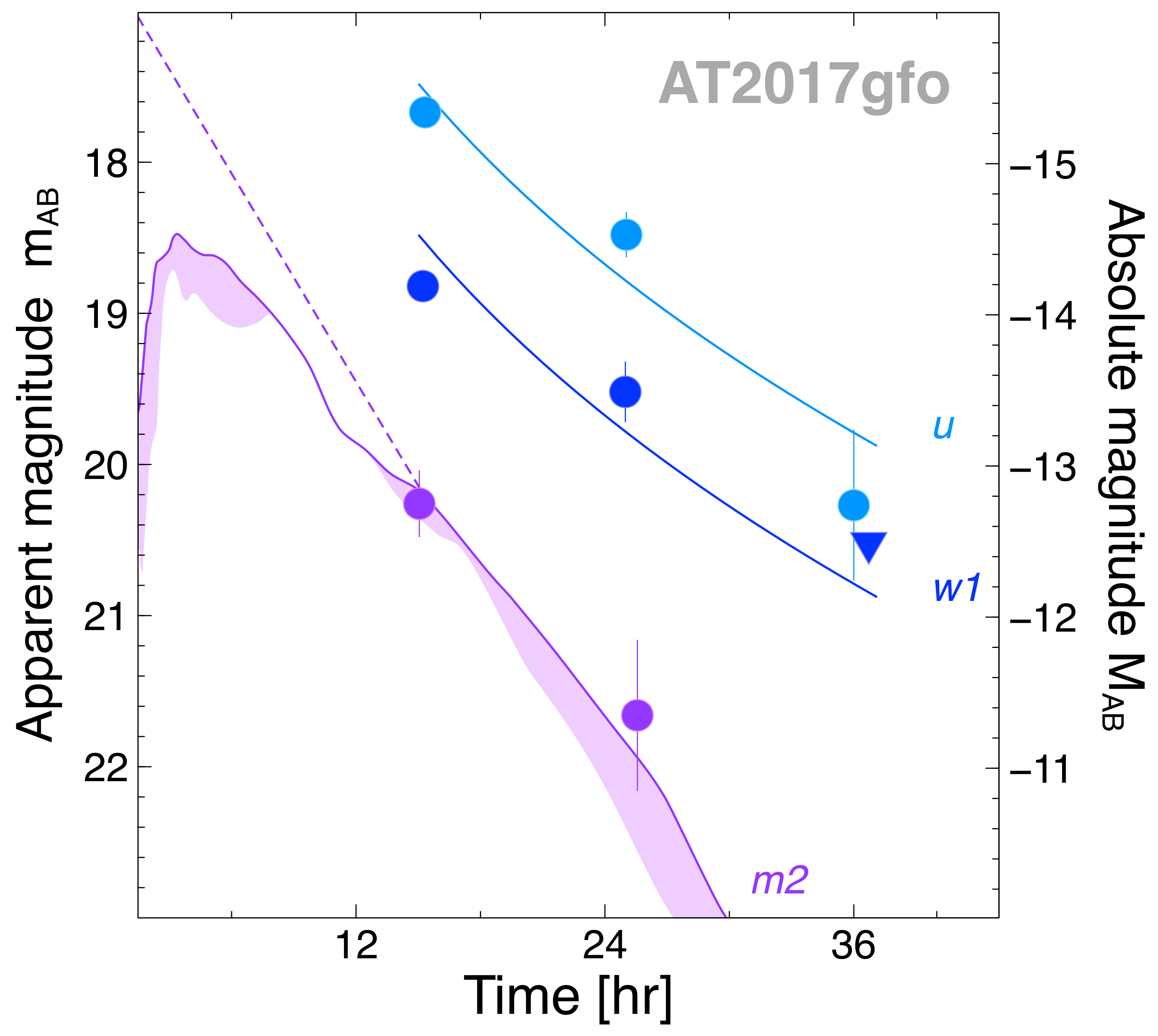
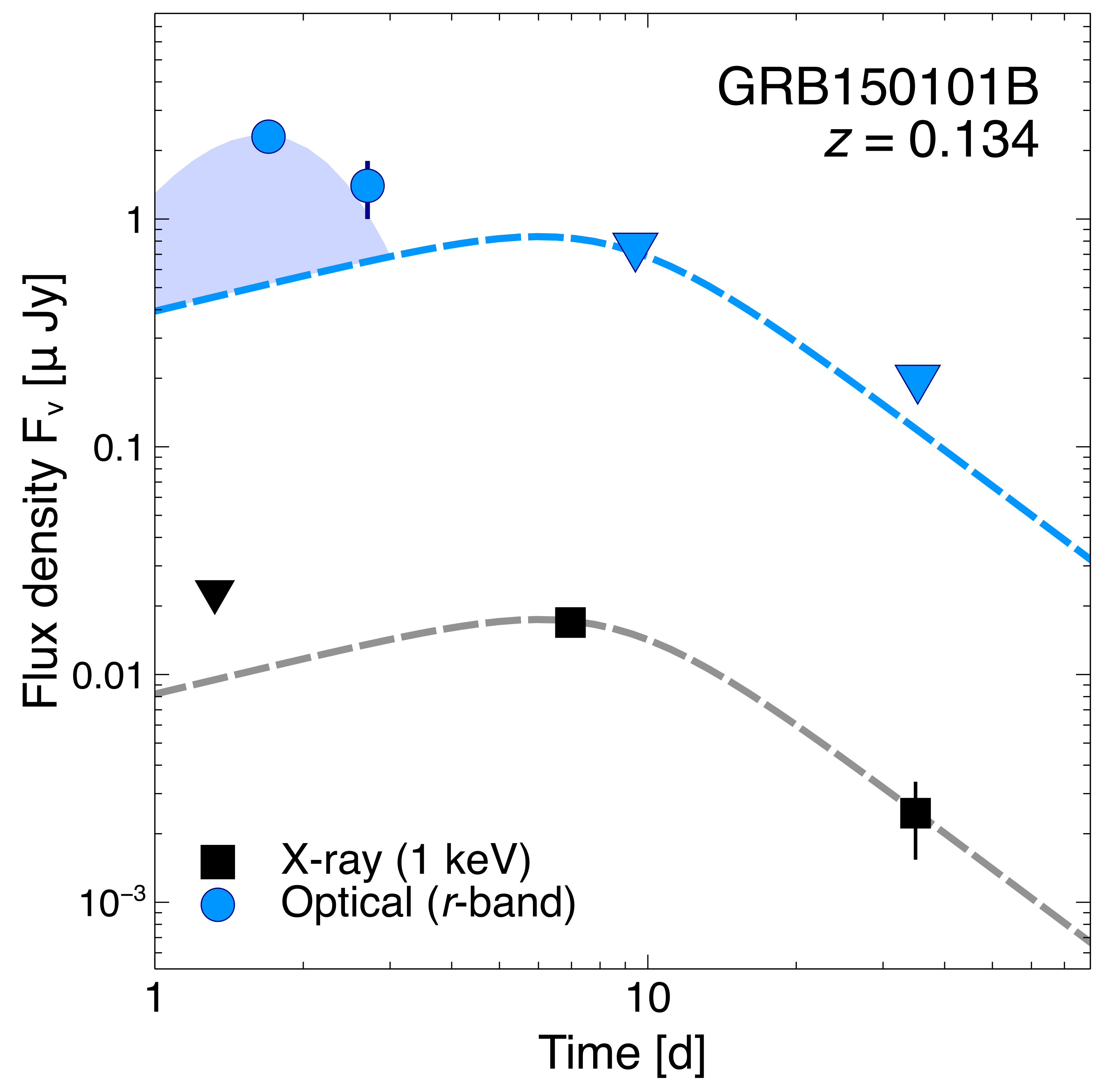
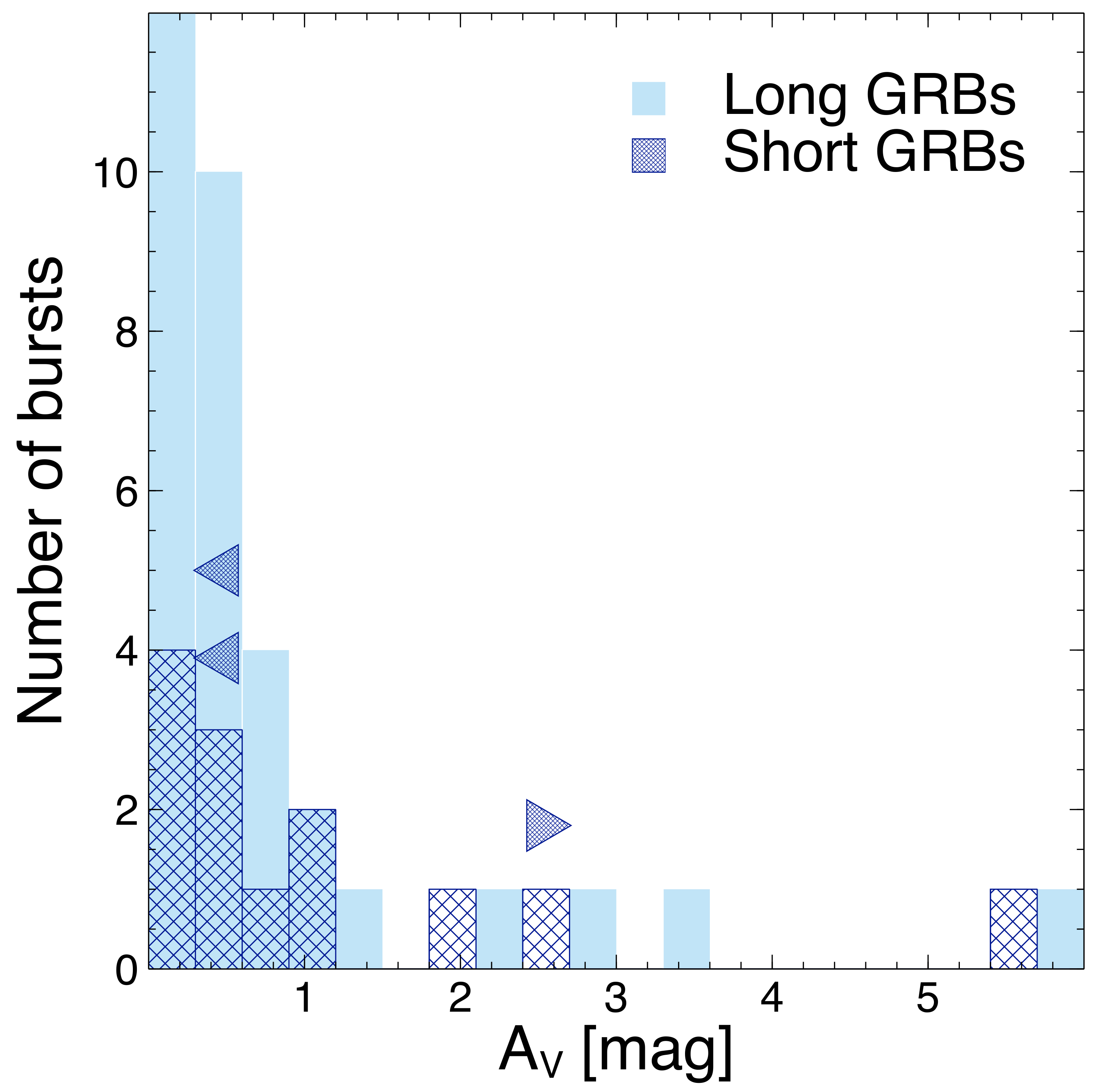
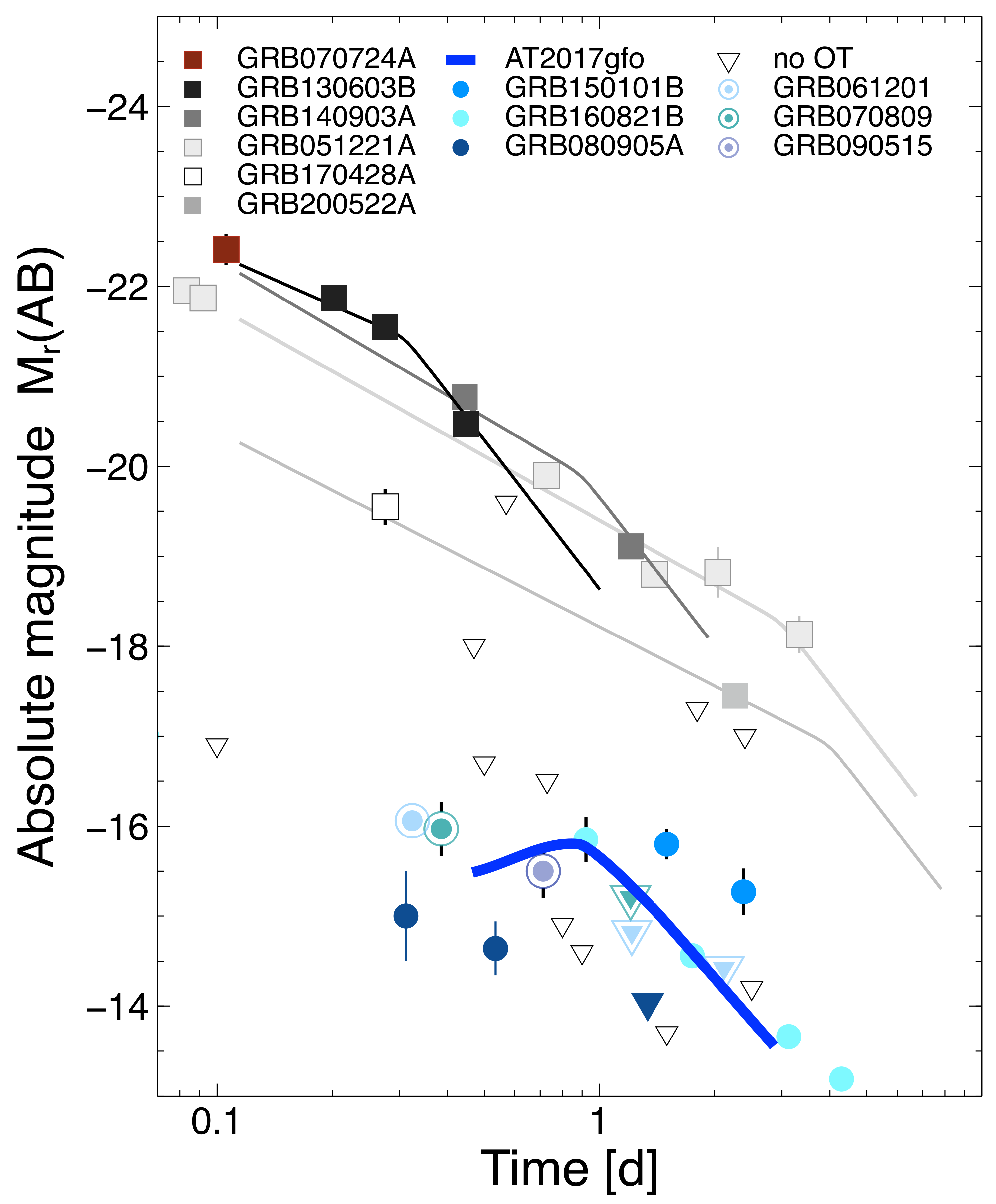
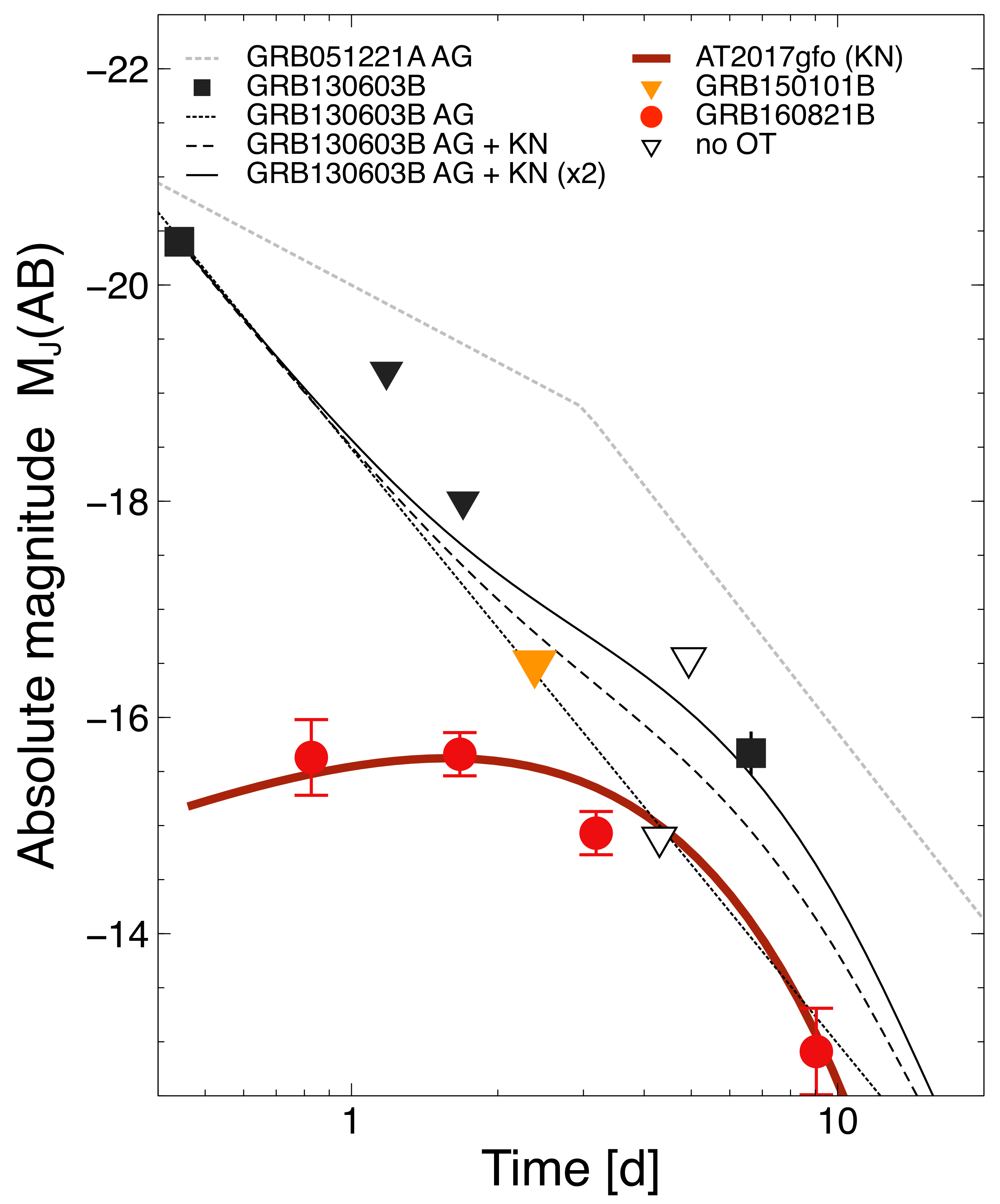
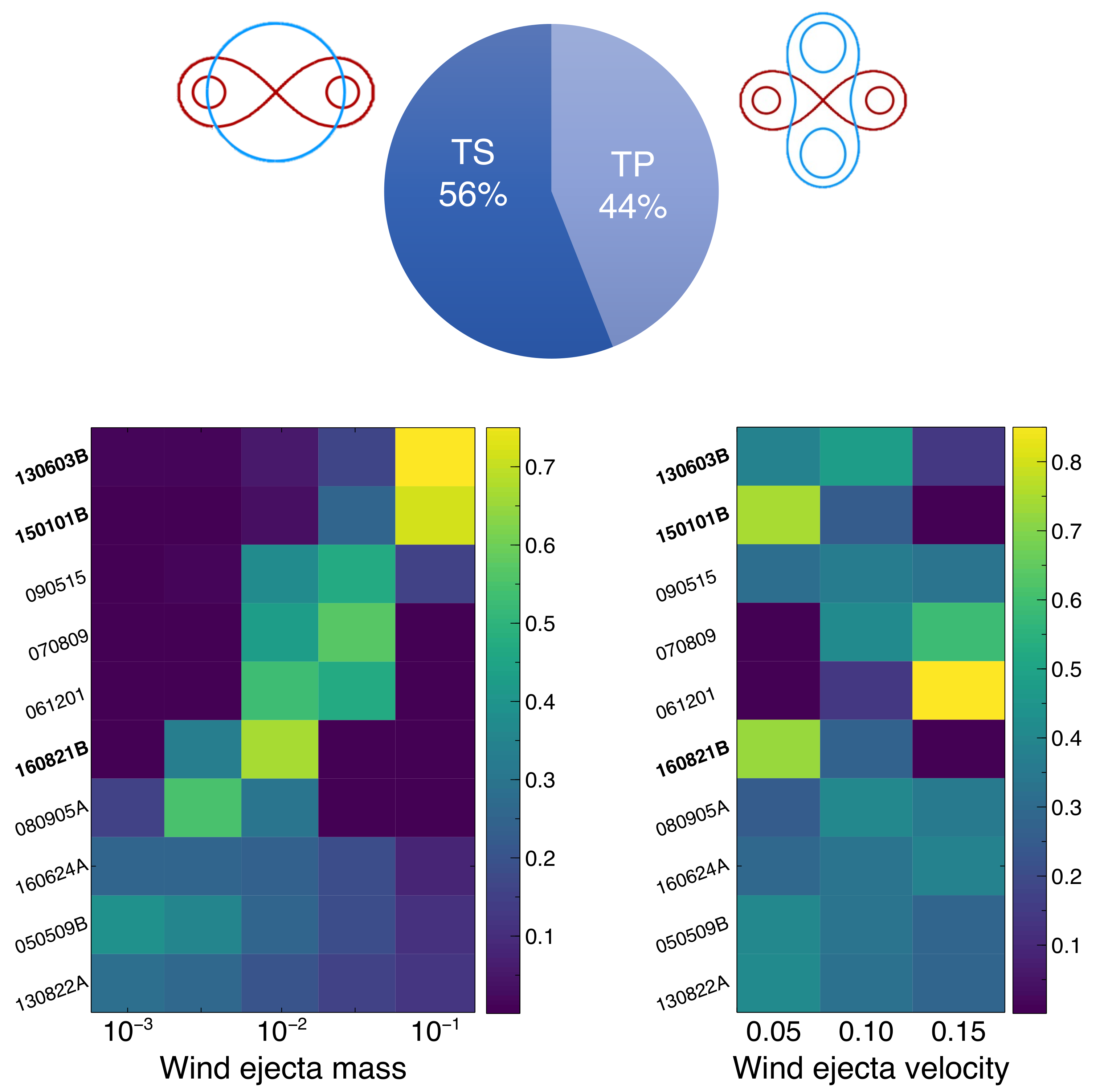
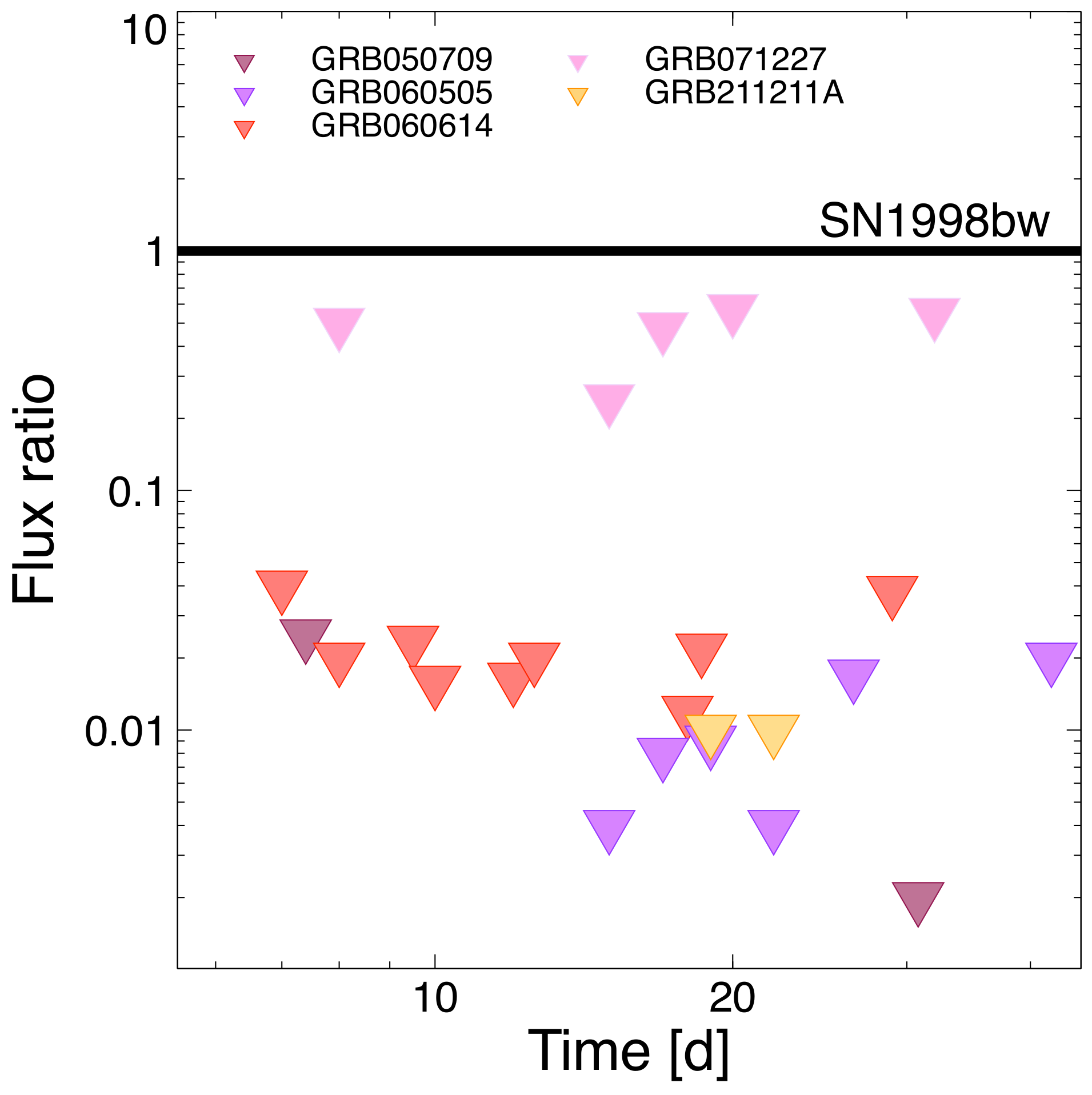
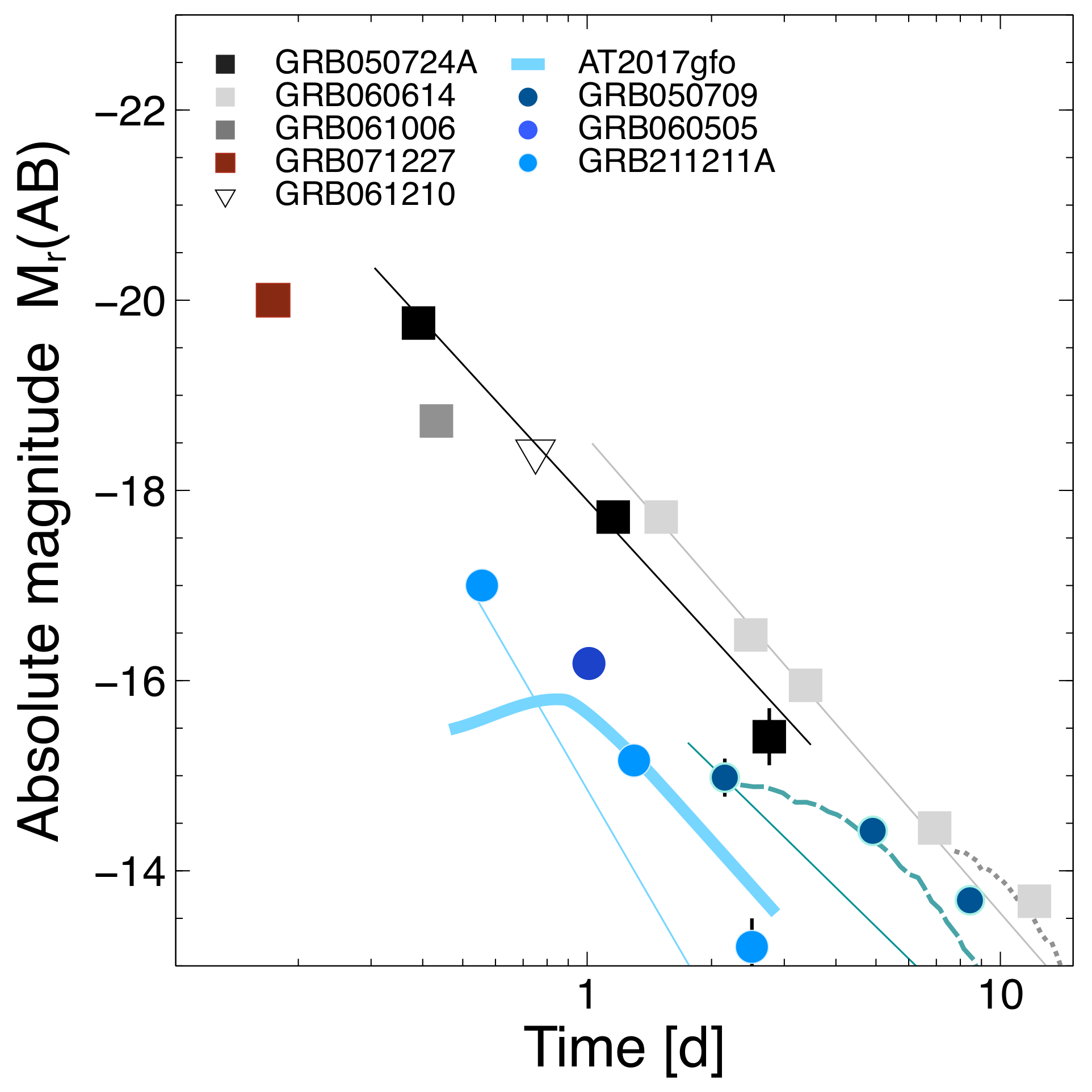
| GRB | Redshift 1 | Comment |
|---|---|---|
| Group 1 | ||
| 051221A | 0.5464 | Afterglow dominated |
| 070724A | 0.4571 | Dust obscured |
| 080905A | 0.1218 | Possible kilonova |
| 130603B | 0.3565 | Candidate kilonova |
| 140903A | 0.3510 | Afterglow dominated |
| 150101B | 0.1341 | Candidate kilonova |
| 160821B | 0.1613 | Candidate kilonova |
| 170428A | 0.454 | Afterglow dominated |
| 200522A | 0.5541 | Afterglow dominated |
| Group 2 | ||
| 050509B | 0.225 | No OT |
| 060502B | 0.258 | No OT |
| 061201 | 0.111/0.084 | Hostless/Possible kilonova |
| 070809 | 0.218/0.473 | Hostless/Possible kilonova |
| 090515 | 0.403 | Hostless/Possible kilonova |
| 100206A | 0.4068 | No OT |
| 100625A | 0.452 | No OT |
| 101224A | 0.4536 | No OT |
| 120305A | 0.225 | No OT |
| 130822A | 0.154 | No OT |
| 150120A | 0.4604 | No OT |
| 150728A | 0.461 | No OT |
| 160624A | 0.4833 | No OT |
| 210919A | 0.2415 | No OT |
| GRB | (s) [15–150 keV] | (s) [50–300 keV] | Redshift 1 | Comment |
|---|---|---|---|---|
| 050709 2 | 155 ± 7 | 0.7 ± 0.1 | 0.1606 | Possible kilonova |
| 050724A | 99 ± 9 | 0.35 ± 0.13 | 0.254 | Afterglow dominated |
| 060505 | ∼4 | – | 0.0894 | Possible kilonova |
| 060614 | 109 ± 3 | 87 ± 5 | 0.1255 | Possible kilonova |
| 061006 | 130 ± 30 | 0.53 ± 0.10 | 0.436 | Afterglow dominated |
| 061210 | 85 ± 13 | 0.06 ± 0.02 | 0.4095 | No OT |
| 071227 | 140 ± 50 | 1.5 ± 0.3 | 0.381 | Dust obscured |
| 080123 | 120 ± 60 | 0.37 ± 0.02 | 0.495 | No OT |
| 180618A | 47 ± 11 | 1.4 ± 0.3 | 0.554 | Afterglow dominated |
| 211211A | 50.7 ± 0.9 | 42.8 ± 1.3 | 0.0785 | Candidate kilonova |
Disclaimer/Publisher’s Note: The statements, opinions and data contained in all publications are solely those of the individual author(s) and contributor(s) and not of MDPI and/or the editor(s). MDPI and/or the editor(s) disclaim responsibility for any injury to people or property resulting from any ideas, methods, instructions or products referred to in the content. |
© 2023 by the author. Licensee MDPI, Basel, Switzerland. This article is an open access article distributed under the terms and conditions of the Creative Commons Attribution (CC BY) license (https://creativecommons.org/licenses/by/4.0/).
Share and Cite
Troja, E. Eighteen Years of Kilonova Discoveries with Swift. Universe 2023, 9, 245. https://doi.org/10.3390/universe9060245
Troja E. Eighteen Years of Kilonova Discoveries with Swift. Universe. 2023; 9(6):245. https://doi.org/10.3390/universe9060245
Chicago/Turabian StyleTroja, Eleonora. 2023. "Eighteen Years of Kilonova Discoveries with Swift" Universe 9, no. 6: 245. https://doi.org/10.3390/universe9060245
APA StyleTroja, E. (2023). Eighteen Years of Kilonova Discoveries with Swift. Universe, 9(6), 245. https://doi.org/10.3390/universe9060245






